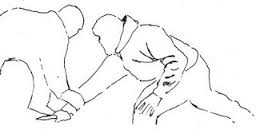I just got asked about knife disarms by someone who realized most of them are BS
****
Actually I can’t answer this question.
That’s because the most accurate answer I can give is “It depends.”
There are three terms I want to introduce you to
1- Wicked problem
A wicked problem is a problem that is difficult or impossible to solve because of incomplete, contradictory, and changing requirements that are often difficult to recognize. The use of term “wicked” here has come to denote resistance to resolution, rather than evil.[1] Moreover, because of complex interdependencies, the effort to solve one aspect of a wicked problem may reveal or create other problems.
https://en.wikipedia.org/wiki/Wicked_problem
2-Probalistic
Situation or model where there are multiple possible outcomes, each having varying degrees of certainty or uncertainty of its occurrence. Probabilistic is often taken to be synonymous with stochastic but, strictly speaking, stochastic conveys the idea of (actual or apparent) randomness whereas probabilistic is directly related to probabilities and therefore is only indirectly associated with randomness. Thus it might be more accurate to describe a natural event or process as stochastic, and to describe its mathematical analysis (and that of its consequences) as probabilistic.
http://www.businessdictionary.com/defini…/probabilistic.html
3- Mutable problem
This is my own term for things changing in the middle of a situation. You know the old ‘Don’t change horses in the middle of a stream?’ Well this is the damned horse changing under you. The conditions that existed two seconds ago that made A the appropriate response have just changed so 27 is now the ‘right’ response. But if you keep on going with A, you’re going to land in deep trouble.
I tell you this because ALL of those apply to what you’re talking about in spades. The situation really does dictate. AS does what the guy does.
I have actually intentionally disarmed someone ONE TIME! And it was a confluence of circumstances. I was in a laundrymat deciding if I could get away with bundling two tube socks with different color tops. (Hey it was going to be under my pants right?) Anyway I hear my girlfriend go “Gah gah gah” and I look up and there’s a guy holding a knife on me. Now at the time I was teaching knife work, so I looked up and saw someone holding a knife in a dangerous manner. Without thinking I stripped it out of his and with a “GIVE ME THAT!” Where upon I started wagging my finger (and my tube sock) at him and chiding him. “Gawd damnit someone could get hurt!”
First of all the guy turned white. Which was no small feat. Second of all, I realized the guy wasn’t one of my students, but a mugger. I looked down at the knife in my hand and got mad. He took me looking away as a time to run.
Now would I EVER recommend someone do what I did. Not only no, but HELL NO! But more than that, it only worked because the guy was trying to mug me, not kill me.
Weird thing, MOST violence comes with instructions how to avoid it — and most of the time, it’s not a lie. This applies to both social violence and robbery (asocial/resource predation). There’s a key difference between the two however.
Social violence follows this pattern. “Shut up or I’ll kick your ass.” Guy doesn’t shut up and the attack happens.
A robbery however, looks normal,things are set up then the attack happens. BUT then the attack STOPS and the instructions on how to keep the attack from finishing are given. Pulling weapon, “Give me your wallet.” If the order is complied with the attack doesn’t finish. If the order is resisted ineffectively, the attack finishes.
I tell you that because the ONLY reason I was able to disarm the guy is because he paused. The only thing that saved him was the fact that I (mistakenly) thought he was a student. Had he been there to kill me (and knew how), the odds are I would not have survived as I was busy looking at my socks. Had be been there to kill me but not know how, it’s a coin toss. I might have survived, but there was a good chance I’d be mangled — even though I would have reacted very effectively. (Getting stabbed tells you it’s time for high level of force). I don’t use that level of force on my students though.
Now I have had people try to stab me and my action had the added benefit of disarming them, but I was kind of focusing on not getting a knife in my chest. (This is incidentally where I learned that if you knock the knife out of many people’s hands, they stare blankly at their now empty hand)
Now conversely those people were… lemme see how to put this. They were willing to kill me to get what they wanted, but they weren’t willing to die to achieve it. That’s a real common attitude among attackers in Western culture. It’s not combat, it’s murder. they’re bringing the weapon to get what they want with minimum risk to themselves. As such, when things go wrong, their commitment evaporates. Here’s the big question about that, will they have time to backpedal? (That kind of depends on how effective your response is.)
On the other hand, someone who is out to get you no matter what… well, that ain’t over until it’s over. Even disarmed they’ll still keep coming. You’re going to have to put in a little over time with those guys because it is combat.
So now you understand why the answer to the question is “It depends.”
